How Much Should I Feed My Cat?
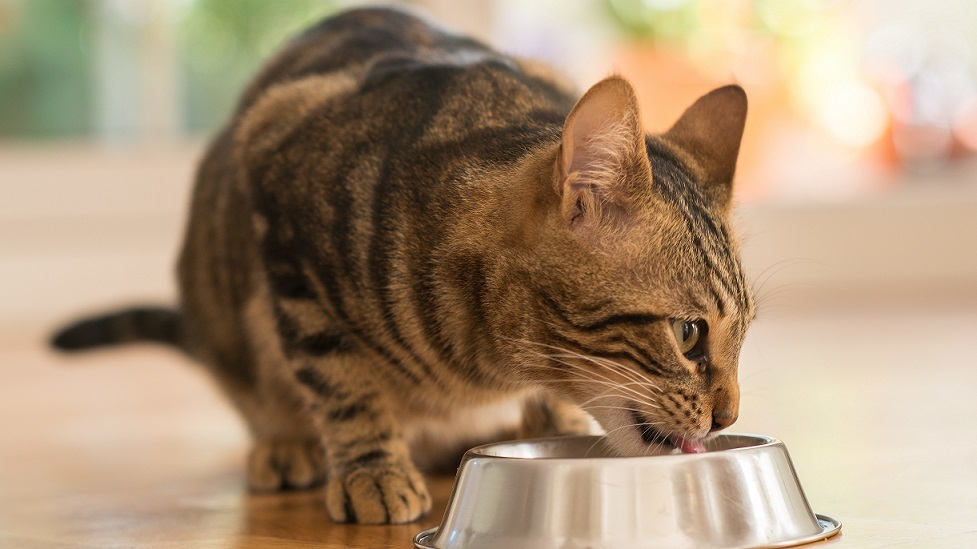
‘How much should I feed my cat?’ is probably one of the questions that cat parents ask the most, along with, ‘what should I be feeding my cat?’.
Unfortunately, there is no simple answer to these questions. A lot of factors come into play, including how picky your cat is! But we’ve compiled all of the information you could need below.
How Much Should I Feed My Cat?
Feeding your cat the correct amount is important as underfeeding can result in weight loss and nutrient deficiencies. However, overfeeding your cat is a more common problem. This is because many pet owners think their cat needs more food than they really do.
This contributes to weight gain, which may lead to other health issues. Obesity can cause a number of issues, such as diabetes, bladder problems, arthritis, cancer and more.
International Cat Care estimates that between 39 and 52 per cent of cats in the UK are overweight or obese. Cats Protection believes this is even higher now, with one in five cats putting on the weight during lockdown.
There are a number of factors that impact how much food you should give your cat, which we have listed below:
Your Cat's Age
It’s important to feed your cat food that’s suitable for their age. Most cat food packaging will indicate which life stage it is aimed at (kitten, adult, senior).
Kitten (1-12months)
Just like babies, kittens have small stomachs, so they need to be fed little and often.
The main recommendation is that you feed your kitten three to four meals every day, until they are six months old. Then you can switch to feeding them two to four meals a day.
It’s also important to ensure that your kitten’s food is soft to make it easier to digest. You can do this by feeding your kitten wet food, or by soaking dry food in water or kitten milk.
Do not use cow’s milk as cats are lactose intolerant.
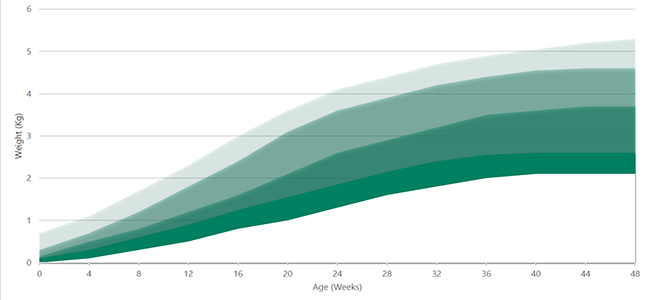
A few years ago we created this kitten weight chart, which shows the ideal weights for kittens from birth to 48 weeks old. You can download it here.
Adult (1 - 8 years)
When your cat reaches one, it’s then considered an adult so you can move it onto an adult’s diet. A healthy adult cat generally requires around 240 calories per day, which can be accomplished in a number of ways.
We will discuss this in more depth later, but generally you can feed your adult cat once or twice a day, or leave dry food out all day for it to graze on. If you’re choosing the second option ,it’s recommended to weigh out your cat’s food at the start of the day and leave it out for them.
Senior (8+ years)
By the time your cat reaches the age of 8, they are considered senior. This means their nutritional needs have changed, so their food should have less protein and fats and more vitamins to keep them healthy.
Senior cats find it harder to break down fat and protein in their food. You can give them special senior food that contains less of these elements, to make their food easier to digest. Just as with kittens, softer food is also recommended.
Cats are known to become even fussier as they get older, as a reduced sense of taste and smell can make them more picky. If your cat is refusing to eat, speak to your veterinarian immediately.
Your Cat’s Weight
Age and weight are probably the two most important variables when it comes to choosing how much to feed your cat. If your cat is losing weight, then you need to increase the amount you are feeding it, and vice versa.
It’s recommended to weigh your kitten every 1 to 2 weeks to keep an eye on their growth, and an adult cat every 2 months. The Marsden V-24 Veterinary Scale is perfect for home use, and currently on offer at £35.00 ex VAT.
Alternatively, investing in a precision scale such as the Marsden V-22 Veterinary Scale is the professional choice for veterinary practitioners. This scale is accurate to 5g, and is used by professionals across the UK.
One way to weigh your cat is to place it on the scale and use the hold feature if they are wiggly. Alternatively place a carry cage on the scale, zero the scale and then place the cat in the cage to weigh it.
One final option is to weigh yourself on a bathroom scale both with and without your cat and work out the difference. However this may not be as precise as you’ll be weighing a larger amount, so it will not be as precise. Plus bathroom scales aren't the most accurate scales.
Activity Level
If your cat is a house cat then they’re likely to live a more sedentary lifestyle than outdoor cats. Therefore, their diet should contain less calories to reflect their energy requirements.
Is Your Cat Spayed or Neutered?
Believe it or not, these procedures can actually impact how many calories your cat burns during the day.
Sterilisation can cause your cat to want to eat more. This change to their metabolism can mean your cat has more appetite, but their energy requirement will actually be a lot lower. It’s important not to overfeed your cat during this time.
Is Your Cat Pregnant?
Pregnant cats need to eat more calories than normal in order to get the nutrients needed for themselves and their kittens. So, they are likely to eat more and more often to keep their energy up. You could try changing your cat onto a kitten food diet, to get the extra nutrients she needs.
It’s not uncommon to be feeding your pregnant cat 50% more than she eats normally, with some even eating twice as much!
However it’s important not to overfeed, as this can result in obesity. Excess fat can cause issues, such as prolonged labour.
Does Your Cat Have Any Health Conditions?
If your cat has any health conditions, such as diabetes, you may need to tailor your cat’s diet to meet these requirements. Speak to your veterinarian for more information.
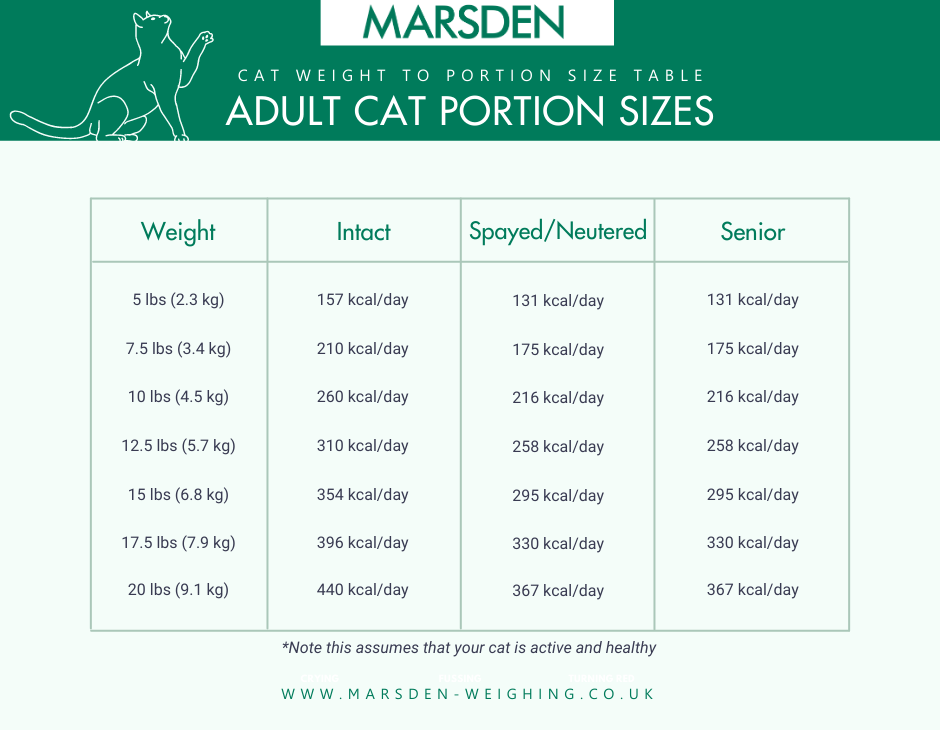
Here are the recommended portion sizes for a healthy, active adult cat, based on their weight. If your cat is overweight or underweight or does not have a body condition score of 5, this may differ.
Should I Feed My Cat Wet Food or Dry Food?
Many cat owners feed only dry food to their felines, while some owners serve a mixture of dry and wet foods. Whether you serve wet food, dry food, or a blend of the two, is really between you and your cat.
There are a number of positives and negatives for both sides, although your picky cat may have the final say.
Dry Cat Food
Dry food has a number of benefits, both for you and your cat.
The main benefit is that dry cat food is cheaper than wet cat food. You can also buy it in bulk as it has a longer shelf life, even after opening.
This also means that you can utilise the ‘free feeding’ stance as you can simply weigh out your cat food in the morning and leave it out for your cat to pick at whenever they’re hungry. It’s easy to measure, easy to use and can even keep your cat’s teeth healthy.
Some of the downsides include that you need to encourage your cat to drink more, as they won’t be getting as much liquid from their food. Additionally, some cats may prefer the smell and texture of wet food.
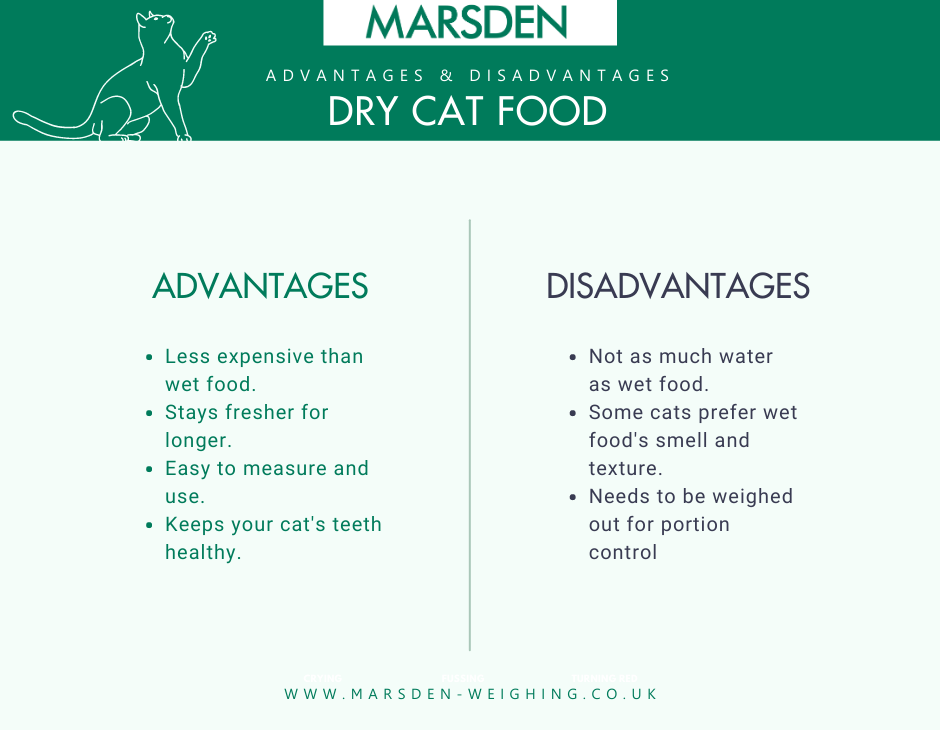
Wet Cat Food
The main benefit of wet food is the higher water content. This can significantly help cats with urinary and kidney issues to ensure they get the amount of water they need, according to PetMD. Because of the high water content, this food has less calories than dry food. This makes it ideal if your cat needs to lose weight, but not if they’re pregnant and need to gain weight.
Most wet foods come in tins or sachets, which makes them easy to measure as they usually single serve pouches. Some cats may prefer having fresh meals every time, although this may not be ideal if you have a busy morning or evening and don’t have time to set it out.
Wet food can also spoil quickly. If you’re not at home to take the food away after 2 hours, then it’s recommended you switch to dry food. If a cat eats wet food after 2 hours, it may have formed bacteria that can be detrimental for your cat’s health.
Finally the softer texture is ideal for senior cats and kittens, who may find dry food to be too tough.
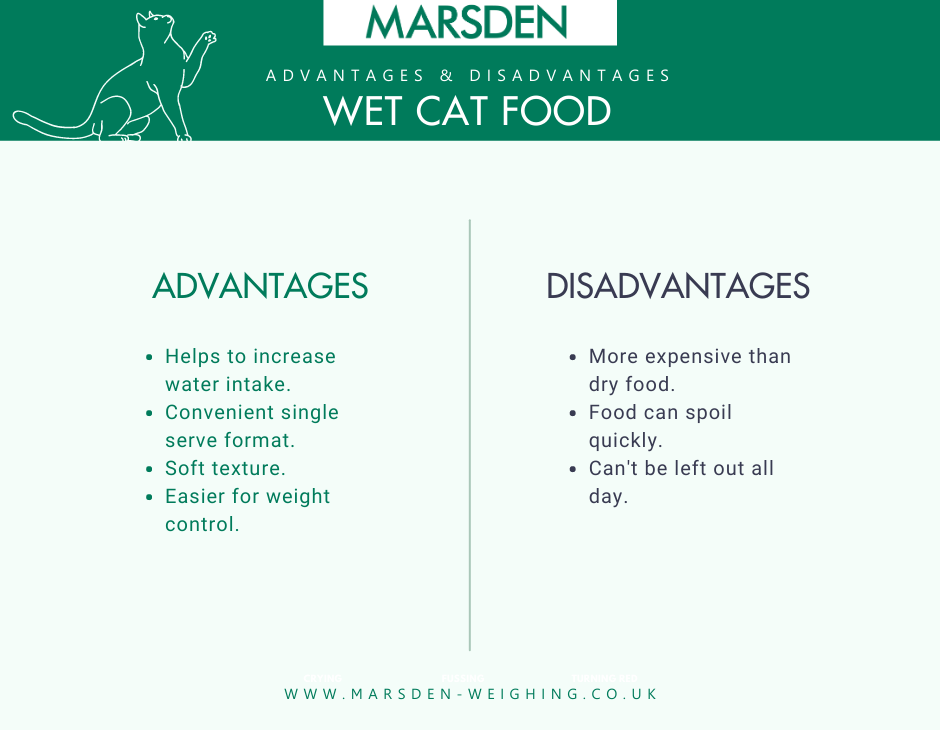
Mixed or Blended Feeds
By mixing dry cat food with wet cat food, your cat can get additional water, while still getting the benefits from dry food. This option offers your cat the best of both worlds, although your cat will probably make the decision for you.
It’s worth noting that if you’ve just purchased your cat, you need to know which food they’ve been fed so far. This is because any sudden changes to their diet can cause issues like diarrhoea. Simply ask which food they’ve been eating and slowly transition them to their new food after they’ve settled in their now home.
How Should I Measure Out My Cat’s Food?
In our survey, we discovered that 40% of cat owners guessed their cat’s food portions. We believe this could be a reason for the climbing obesity rate in pets.
That’s why we recommend using a digital kitchen scale for measuring your cat food, such as the Marsden B-450 Bench Scale. This scale has precision to the nearest 1g and is waterproof if you end up spilling when preparing your cat’s meals.
By weighing out your cat’s food, you can ensure they’re sticking to their portion sizes and not eating too much or too little.
How Often Should I Feed My Cat?
There are two many methods for feeding your cat and both have a number of factors which affect them:
Free Feeding
Free feeding is also known as grazing, and involves leaving food out for your cat to eat throughout the day.
It’s important to measure out your cat’s portion as they can easily overfeed if you put too much in. This means your cat can go exploring and can come back and eat some food whenever they want.
Another key benefit is that you can put the cat’s food out on a morning and not need to worry about it for the rest of the day. This is only possible with dry food, of course.
However, this is dependent on your cat’s appetite. If they tend to wolf down all their food in one sitting, then leaving out food for them all day will not be effective. Every cat is different so you could trial this with your cat and, if it doesn’t work try option two.
Scheduled Feeding
The other option is to carry out scheduled feeding, where you feed your cat one or two times a day. Two meals is better than one, as cats still prefer to eat less and often compared to all at once. By doing this, you can also give your cat set meal times and spread out their daily calories between different meals.
Can I Give My Cat Treats?
Of course you can give your cat treats. However it’s important to remember that these additional calories should also factor into their daily calories. They should not be in addition to their allowance or they’ll consume too much and become overweight.
Moderation is key. It’s generally recommended that treats should take up no more than 10% of your cat’s daily calories.
If you are going to give your cat treats, it’s better to give your cat actual treats designed for cats, rather than human food. If you do give them human food, then a bit of cooked chicken or a tinned sardines, tuna or salmon is better than raw meat.
What Should I Not Feed My Cat?
Just as with any pet, there’s a number of items that you shouldn’t feed your pet. These can cause all sorts of health problems and some can even be potentially fatal.
It’s best to keep these foods out of your cat’s reach:
- Milk and other dairy products
- Chocolate
- Onions & Garlic
- Alcohol
- Raisins/sultanas and Grapes
- Bread and Yeast
- Raw eggs, raw meat, raw fish
- Tea, Coffee and Energy Drinks
- Avocado
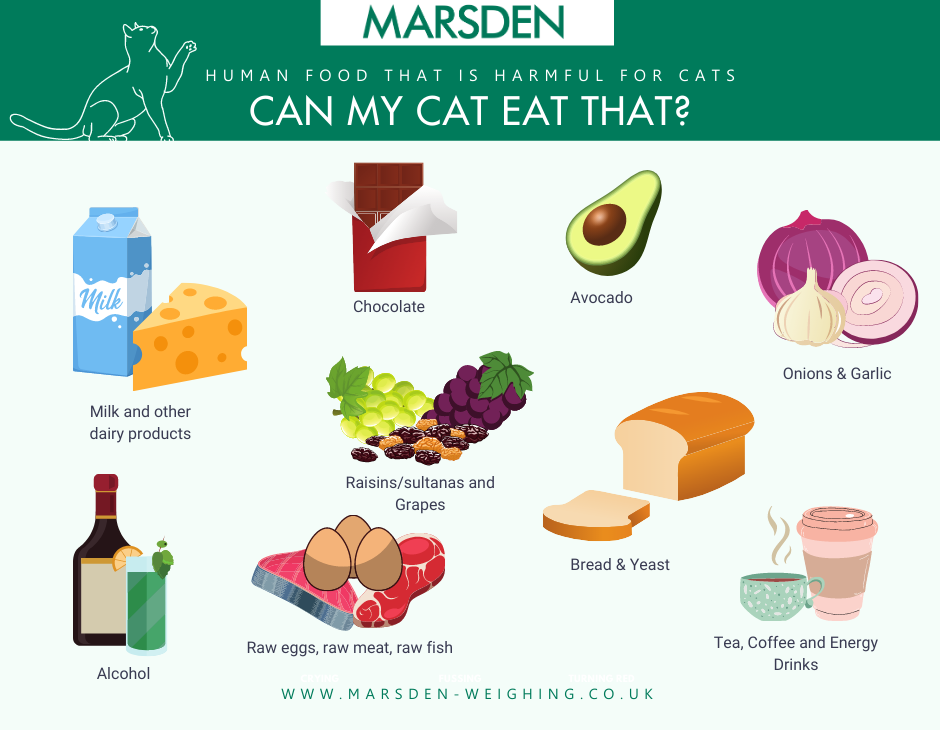
Top Tips for Feeding Your Cat
- Try to always serve your cat’s food at room temperature. If you keep your wet food in the fridge, put it in the microwave for a few seconds before serving.
- Don’t top up your cat’s bowl just because it’s empty, that can result in overfeeding.
- Feeding a cat in the same place and at the same times each day is best
- Choose a shallow bowl. Cats prefer these as they can see around them as they eat and drink.
- Pottery bowls are easy to clean and don’t build up a foul odour like plastic bowls.
- Place your cat’s bowl on a surface that can be easily cleaned, or use a cat feeding mat.
- If you have more than one cat, separate their bowls. This can help avoid any confrontation during meal times.
- Always keep food and water bowls well away from litter as cats don’t like to eat where they use the toilet.
- Use treat balls to help your cat work off some energy while making a meal last longer. These don’t actually have to contain treats, but can contain small amounts of dry food.
It’s important to remember that each cat is different, so there’s no one size fits all when it comes to choosing how much you should feed your cat, and what you should, but hopefully this guide has helped you.
If you have any further questions, please comment them below and we will do our best to answer them.
Related Products
Further Reading
Your cat’s weight and the amount of food they eat go hand in hand. Work out if your cat is a healthy weight using our helpful guide.
Are you still not sure whether your cat is a healthy weight? Use these 5 tips to work out whether your cat is overweight.
We donated 12 weighing scales to Battersea Dogs & Cats home to help them look after their rescues.